 |
 |
| Home | Welcome | What's New | Site Map | Glossary | Weather Doctor Amazon Store | Book Store | Accolades | Email Us |
 | |||||||||||||||||
The Aurora
Auroras form within an oval band centered at each magnetic pole; the band extends outward approximately 3000 km (1900 miles) from the center during quieter solar periods. However, when the upper atmosphere and Earth's magnetic field (a region called the magnetosphere) are highly disturbed -- a geomagnetic storm -- the auroral oval may extend much further from the pole, and during high periods of solar activity, may push as far equatorward as 35o to 40o. During an unusually large geomagnetic storm disturbance in 1909, an aurora was visible at Singapore, located on the geomagnetic equator. [For more on conditions which form the geomagnetic storms which lead to spectacular auroral events, click here.] The lights we call the aurora is produced by the interaction of the high-energy particles (usually electrons and hydrogen ions carried by the solar wind) with the oxygen and nitrogen atoms in the Earth's upper atmosphere. The process is similar to that which lights a neon lamp: neon gas is excited to emit light by electrical currents flowing through the tube. The high-energy particles from the sun are channeled by the Earth's magnetic field to collide with the neutral and ionized atoms of the outer atmosphere high above the geomagnetic poles. The collisions force some of the electrons in those atoms to become excited as they absorb the energy and are pushed to a higher energy state. When the excited electrons finally relinquish that extra energy upon returning to their initial, lower energy state, they release photons of visible light. The particular colours we see in an auroral display depends on the specific atmospheric gas struck, its electrical state at the time of collision, and the energy of the extraterrestrial particle involved in the collision. 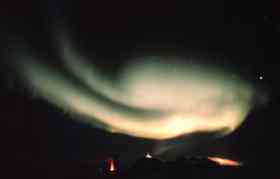 Each atmospheric gas glows with specific colors. For example, atomic oxygen is responsible for two primary auroral colors: green-yellow (wavelength of 557.7 nanometres (nm)) and red (630.0 nm). The brightest and most common auroral color, a brilliant green-yellow, is produced by those oxygen atoms at roughly 100 km (60 miles) altitude. High-altitude oxygen atoms (about 320 km (200 miles) above Earth) may produce rare, all-red auroras if struck by very energetic solar particles. 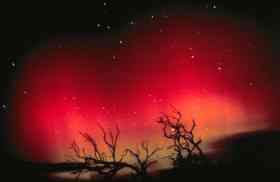 Nitrogen molecules in an ionized state will produce blue light while electrically neutral nitrogen molecules create purplish-red auroral colours. The mix of these emissions from different atoms and at different altitudes produce the great variability of auroral colours. 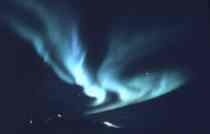 Auroras come in many shapes and sizes as well as a variety of colours. A display may change colours or pulse in intensity as the ever-changing geomagnetic field is disturbed by the solar wind and additional solar particles stream into the atmosphere. Aurora may appear to hang static in the sky, or they may dance and flutter, or even appear to explode upward along magnetic field lines. 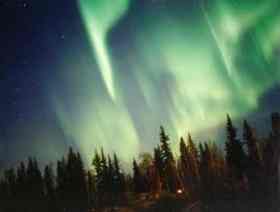 There are six main shape categories for auroral displays: arcs or curtains, bands, coronas, patches, rays and veils. Auroral arcs or curtains typically cover large areas of sky. They are usually an evenly curved arc of light with a smooth lower boundary, which may extend from horizon to horizon. Arcs may dance and turn, rippling like a curtain responding to a light breeze. Auroral bands are similar to arcs but with a folded or uneven lower edge. Both bands and arcs may have variations: streaming when a sudden increase in brightness passes horizontally across it; flaming when sudden bursts of light begin at the bottom and flare upward; and rayed when composed of many distinct rays. Auroral coronae are rayed arcs or bands seen from below so that the light appears as sunbeams spraying out in all directions. Auroral patches are small areas of light that look like a cloud in the night sky. Often they appear to flash or pulse, disappearing and reappearing over a short period of time. Auroral rays are thin beams or shafts of auroral light that hang vertically above the observer. Tall rays generally start 100 km (60 miles) above the Earth's surface and extend vertically along the magnetic field for hundreds of kilometres. Auroral veils are large featureless clouds of auroral light. Veils may cover the entire sky with a pale white light. But in exceptional cases, the veils may appear blood-red in colour. Such displays have inspired myths and legends among northern peoples, many of which portend disaster. 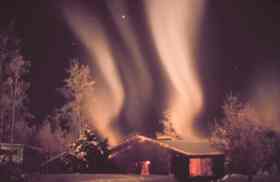 Today, most of us live too close to the overwhelming light pollution of human civilization to see auroral displays with any regularity. And many of us consider the aurora as a winter night phenomenon, but this is only because of the longer and darker nights and clearer skies during the winter season that make the faint light more visible. In fact, as orbiting satellites show, the auroral ring continually glows at each magnetic pole, waxing and waning with variations in the solar wind. These satellites also show us that auroras are common daily events. They dance even in daylight, but the sun's overwhelming light obscures their faint glow in the sky, which is about as strong as starlight, from our sight.
When looking for auroras, here are a few tips:
Note: All photographs and diagrams courtesy of NOAA, US Department of Commerce. Learn More From These Relevant Books
|
|||||||||||||||||
 |
To Purchase Notecard, |
Now Available! Order Today! | |
 |
 |
NEW! Now Available in the US! |
The BC Weather Book: |


